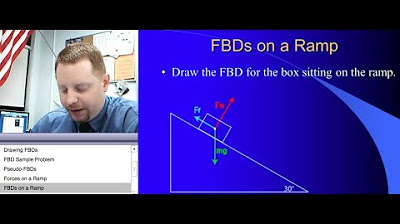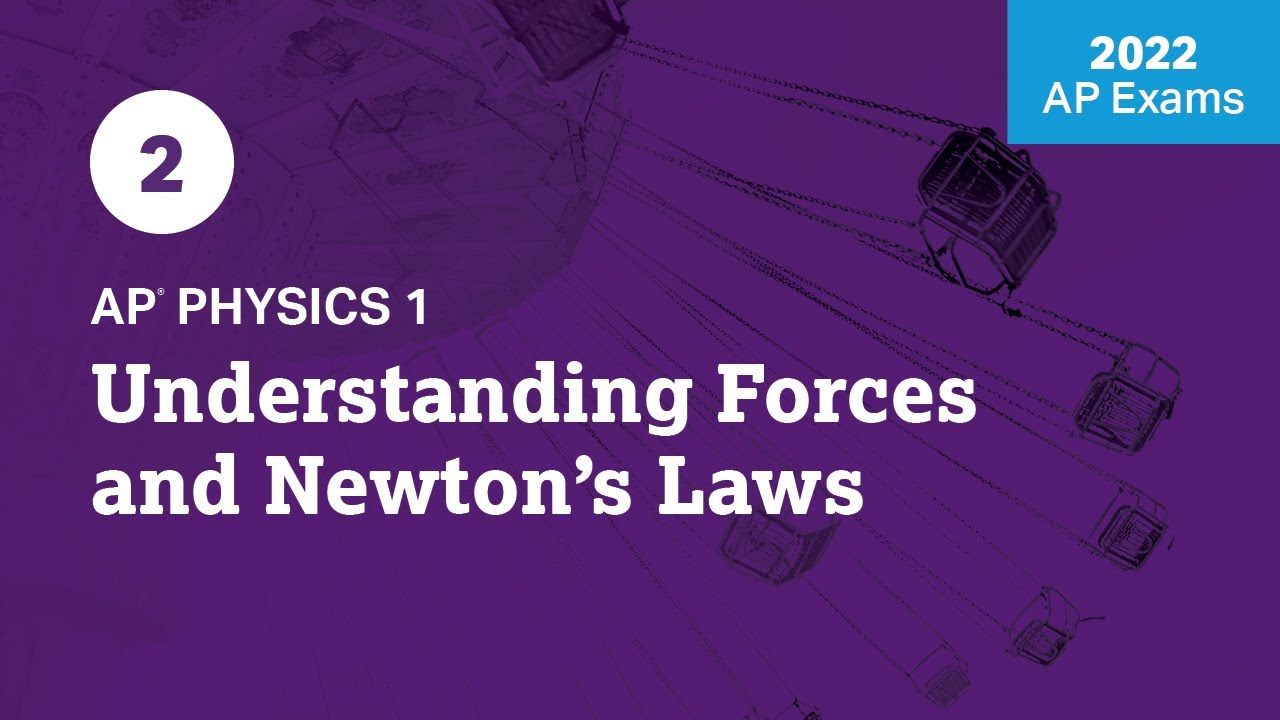Blocks Sliding Down Ramps, and All That: Physics Help Room
TLDRIn this educational video, Elliot introduces the concept of blocks on inclined ramps, a fundamental physics problem that helps students apply Newton's laws. He explains the three-step Newtonian mechanics procedure: drawing the free body diagram, summing forces, and solving for motion. Elliot details the forces acting on a block, including gravity, normal force, and friction, and how they contribute to the block's acceleration down the ramp. He also discusses the importance of understanding static and kinetic friction, and how kinetic friction is calculated. The video concludes with a formula for the block's trajectory and a method to calculate the time it takes to reach the ground, encouraging viewers to practice with provided problem sheets.
Takeaways
- 📚 The video is a physics tutorial focused on blocks on inclined ramps, a common topic in introductory physics classes.
- 🔍 The tutorial aims to apply Newton's laws to a moderately complex system to understand the principles better.
- 📐 The setup involves a block of mass 'm' on a ramp inclined at an angle 'theta' with a length 'l'.
- 🕒 The block is released from rest at the top of the ramp, and the goal is to determine when it will hit the ground.
- 📈 The process involves a three-step procedure: drawing a free body diagram, summing forces, and solving the equation F = ma.
- 🧲 Forces acting on the block include gravity, the normal force from the ramp, and the frictional force.
- 📉 The frictional force is identified as kinetic friction, which is proportional to the normal force and characterized by the coefficient of kinetic friction 'mu'.
- 📚 The tutorial explains how to decompose gravity into parallel and perpendicular components with respect to the ramp.
- 📉 The acceleration of the block is derived from the forces acting on it, resulting in an equation involving sine and cosine of theta.
- 📝 The trajectory of the block as a function of time is given by a formula that includes the acceleration and initial conditions.
- ⏱ To find the time it takes for the block to hit the ground, set the position 'q' equal to the ramp length 'l' and solve for time 't'.
- 📘 Additional resources, including notes and problem sheets, are available on the instructor's website for further practice.
Q & A
Why is studying blocks on inclined ramps important in physics?
-Studying blocks on inclined ramps is important because it provides a simple yet effective way to apply Newton's laws to a system, helping students understand fundamental concepts without being overly complicated.
What is the setup of the problem discussed in the video?
-The setup involves a block of mass m placed on a ramp inclined at an angle θ. The block is released from rest at the top of the ramp at t = 0, and the question is to determine when the block will hit the ground.
What is the first step in solving this problem using Newtonian mechanics?
-The first step is to draw the free body diagram, which shows all the forces acting on the block.
What forces are acting on the block on the inclined ramp?
-The forces acting on the block are gravity (mg) pulling straight down, the normal force (N) perpendicular to the ramp, and the friction force (f) pointing up the ramp.
How do you write the equation of motion for the block?
-You write the equation of motion by summing the forces and setting them equal to mass times acceleration (F = ma), considering both parallel and perpendicular components to the ramp.
How do you resolve the gravity force into components parallel and perpendicular to the ramp?
-The gravity force is resolved into mg sin(θ) parallel to the ramp and mg cos(θ) perpendicular to the ramp.
What is the significance of the normal force in this problem?
-The normal force (N) balances the perpendicular component of gravity, preventing the block from moving through the ramp, and it is equal to mg cos(θ).
How is the friction force calculated?
-The friction force is calculated as the coefficient of kinetic friction (μ_k) times the normal force (N), which is μ_k * mg cos(θ).
What is the equation for the acceleration of the block along the ramp?
-The acceleration (a) of the block along the ramp is given by g sin(θ) - μ_k cos(θ).
How do you determine the time it takes for the block to reach the bottom of the ramp?
-The time (t) to reach the bottom of the ramp is determined by setting the position function q(t) equal to the length of the ramp (L) and solving for t, resulting in t = sqrt(2L / a).
What is the role of the coefficient of kinetic friction (μ_k) in the problem?
-The coefficient of kinetic friction (μ_k) quantifies the frictional force between the block and the ramp surface, influencing the acceleration of the block.
How can you verify the correctness of the acceleration formula?
-You can verify the correctness of the acceleration formula by checking the units (which should be meters per second squared) and by considering special cases, such as when the ramp is vertical (θ = π/2) or flat (θ = 0).
What happens to the block's acceleration when the ramp angle θ is zero?
-When θ is zero, the ramp is flat, and the parallel component of gravity is zero, resulting in no acceleration due to gravity along the ramp (a = 0).
Why is it important to practice solving problems related to this topic?
-Practicing solving problems is important because it reinforces understanding of the concepts and methods, helping students to apply Newton's laws and other principles effectively in various scenarios.
What additional resources are provided with the video to aid understanding?
-The video provides free notes and problem sheets with solutions on the presenter's website, which can be used for further practice and reference.
Outlines
📚 Introduction to Blocks on Inclined Ramps
In this educational video, Elliot introduces the concept of blocks on inclined ramps, a fundamental topic in physics that exemplifies the application of Newton's laws to a moderately complex system. Elliot explains the setup involving a block of mass 'm' on a ramp inclined at an angle 'theta' and of length 'l'. The goal is to determine when the block will hit the ground. The process involves drawing a free body diagram, summing forces to apply 'F = ma', and solving for the block's position over time. Elliot emphasizes the importance of understanding the forces acting on the block, including gravity, normal force, and friction, and how these forces can be decomposed into components parallel and perpendicular to the ramp.
🔍 Analyzing Forces and Motion on an Inclined Ramp
This paragraph delves deeper into the forces acting on the block and how they can be mathematically represented. Elliot clarifies the distinction between static and kinetic friction, focusing on the latter for the scenario where the block slides down the ramp. The kinetic friction force is described as being proportional to the normal force, characterized by the coefficient of kinetic friction 'mu_k'. Elliot then integrates this understanding into the force equations, deriving the acceleration 'a' of the block as a function of the incline angle and the coefficient of friction. The acceleration formula is checked for consistency with physical expectations, particularly in the case of a vertical ramp where the block would experience free fall with acceleration 'g'. The trajectory equation 'q(t)' is presented, describing the block's position over time, given the initial conditions of rest at the top of the ramp.
🚀 Calculating Time to Reach the Ground and Additional Resources
The final paragraph addresses the practical application of the derived equations by calculating the time it takes for the block to slide down the ramp and hit the ground. Elliot demonstrates how to solve for time 't' by setting the block's position 'q' equal to the ramp's length 'l' and solving the resulting equation. To reinforce the concepts covered in the video, Elliot provides additional resources, including notes and a problem sheet, which are accessible on his website. He encourages viewers to practice problem-solving and provides solutions for the problems. Elliot concludes the video by inviting feedback and suggestions for future topics, emphasizing the importance of engaging with the material through practice.
Mindmap
Keywords
💡Inclined Ramps
💡Newton's Laws
💡Free Body Diagram
💡Forces
💡Acceleration
💡Kinetic Friction
💡Normal Force
💡Trajectory
💡Coefficient of Kinetic Friction
💡Problem Solving
Highlights
Introduction to the physics of blocks on inclined ramps as a practical application of Newton's laws.
Explanation of the three-step procedure in Newtonian mechanics: drawing a free body diagram, summing forces, and solving for position as a function of time.
Identification of forces acting on a block: gravity, normal force, and friction.
Decomposition of forces into parallel and perpendicular components to the ramp for a more intuitive analysis.
Use of a coordinate system aligned with the ramp to simplify the problem of finding position over time.
Calculation of the perpendicular and parallel components of gravity using trigonometric functions.
Understanding that the normal force does not contribute to the motion in the parallel direction.
Introduction of the concept of kinetic friction and its dependence on the normal force.
Derivation of the acceleration of the block using the kinetic friction force and gravity's parallel component.
Verification of the derived acceleration formula through unit analysis and special case scenarios.
Formulation of the block's trajectory equation as a function of time, given the constant acceleration.
Solution for the time it takes for the block to hit the ground by setting the position equal to the ramp's length.
Availability of notes and problem sheets for further practice and understanding of the concepts discussed.
Engagement with the audience by encouraging them to solve problems and subscribe for more physics content.
Discussion of a problem involving King Sisyphus as a practical application of the concepts learned.
Conclusion of the video with an invitation for feedback and suggestions for future topics.
Transcripts
Browse More Related Video
5.0 / 5 (0 votes)
Thanks for rating:





